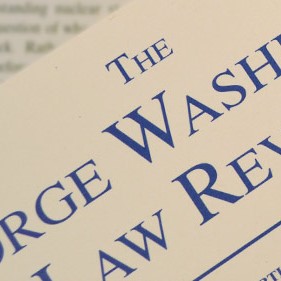Matthew C. Stephenson & Miri Pogoriler · July 2011
79 GEO. WASH. L. REV. 1449 (2011)
In carrying out their duties, federal administrative agencies must often interpret statutes and regulations that are not entirely clear. Sometimes an agency’s interpretation of an ambiguous legal text may not seem like the best or most natural interpretation of that text. Nonetheless, a staple of modern federal administrative law doctrine is the principle of judicial deference to administrative interpretations of both congressional statutes and agency regulations. The seminal case on judicial deference to reasonable agency statutory interpretations is, of course, Chevron U.S.A. Inc. v. Natural Resources Defense Council, Inc. In the context of administrative interpretations of the agency’s own regulations, the leading authority is the Supreme Court’s 1945 decision in Bowles v. Seminole Rock & Sand Co., which held that an agency’s construction of its own regulation should be given “controlling weight unless it is plainly erroneous or inconsistent with the regulation.” More recent Supreme Court cases—including Thomas Jefferson University v. Shalala and Auer v. Robbins—have reaffirmed the Seminole Rock principle of judicial deference to an agency’s reasonable construction of its own regulations.
Although Chevron deference and Seminole Rock deference are closely related, there has been much more thorough exploration of the theoretical underpinnings and practical consequences of Chevron. This has not eliminated doubt or disagreement about the nature, validity, or wisdom of Chevron deference, but a consensus has gradually emerged that Chevron is grounded in a presumption (likely a legal fiction) about congressional intent. That presumption is in turn grounded in a set of pragmatic considerations—most notably expertise, accountability, and uniformity—that are thought to favor administrative over judicial construction. Furthermore, in part because of the self-conscious and sophisticated reflection on Chevron’s justifications, courts and commentators have become increasingly attentive to questions regarding the proper scope and limits of what Professors Merrill and Hickman have described as “Chevron’s domain.” Although Chevron was widely seen as replacing an open-ended, multifactor inquiry with a more rule-like framework, a strain in the doctrine and commentary has long suggested that the case for Chevron deference is not equally strong in all contexts, and indeed such deference might sometimes be inappropriate.
This view reached its apotheosis in United States v. Mead Corp., in which the Supreme Court held that some agency statutory interpretations—particularly those contained in interpretive rules, informal orders, or other pronouncements issued without extensive procedures—were presumptively not entitled to Chevron deference. Such interpretations fall outside Chevron’s domain, and therefore receive at most a measure of judicial respect, pursuant to the Court’s 1944 decision in Skidmore v. Swift & Co. Although Mead and much subsequent commentary emphasized procedural formality as the key consideration marking the boundaries of Chevron’s domain, other strands of the doctrine have suggested that something less than full Chevron deference might be appropriate when, for example, several agencies share interpretive authority over the same statute, when an agency’s interpretation of a statutory provision has been inconsistent over time, or when the interpretive question is unusually fundamental or important. The academic literature is rife with proposals for further refinements to Chevron’s domain, as well as defenses and criticisms of the limits the Court has already developed.
By contrast, courts and commentators have paid less attention to analogous questions regarding Seminole Rock’s domain. Indeed, Seminole Rock has attracted less attention and discussion than Chevron in general, and the discussion that does exist has tended to focus on wholesale critiques or defenses of Seminole Rock, rather than questions regarding possible limits on the set of administrative interpretations that qualify for such deference. Yet this is starting to change: emerging strands of both the academic literature and the caselaw have begun to take seriously, and to grapple with, questions regarding Seminole Rock’s proper scope. This trend has accelerated in the wake of Mead. Indeed, post-Mead circuit court cases have sent mixed signals regarding the effect of that decision on Seminole Rock deference. This Article builds on prior work by posing—and suggesting some preliminary answers to—the question of whether there ought to be limits to Seminole Rock’s domain, comparable (though perhaps not identical) to the limits that have been advocated, and in some cases recognized, for Chevron’s domain.
We have three objectives in this Article: the first is descriptive, the second analytic, and the third prescriptive. Our descriptive objective is to provide a succinct summary of the state of the current doctrine regarding the limits—or lack thereof—on Seminole Rock’s domain. Our analytic objective is to develop a taxonomy of the considerations that courts might plausibly use to develop midlevel doctrinal rules or presumptions that would limit Seminole Rock’s domain, and to assess the costs and benefits of these different doctrinal possibilities. Our prescriptive objective is to advocate—tentatively—a subset of these possible rules. Of these three objectives, the analytic objective is paramount. More important than any particular doctrinal change, is the development of a more sophisticated framework for thinking about issues of Seminole Rock’s domain, so that these issues and problems can be confronted squarely and explicitly.

